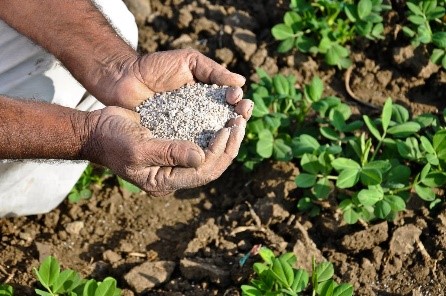‘One Nation One Fertilizer’ policy
‘One Nation One Fertilizer’ policy

Why in news?
In an order on August 24, the Union Ministry of Chemicals and Fertilisers issued a memo announcing the implementation of the “One Nation One Fertiliser” scheme under which a single brand and logo for fertilisers will have to be used by all manufacturers under the Centre’s fertiliser subsidy scheme newly renamed as a Prime Minister’s scheme- “Pradhanmantri Bhartiya Janurvarak Pariyojna” (PMBJP).
What is the ‘One Nation One Fertiliser’ scheme?
- Under the scheme, all fertiliser companies, State Trading Entities (STEs) and Fertiliser Marketing Entities (FMEs) will be required to use a single “Bharat” brand for fertilisers and logo under the PMBJP.
- The single brand name for UREA, DAP, MOP and NPKS etc. would be BHARAT UREA, BHARAT DAP, BHARAT MOP and BHARAT NPK etc. respectively for all Fertiliser Companies, State Trading Entities (STEs) and Fertiliser Marketing Entities (FMEs).
- The memo outlines the specifications of the new packaging for companies–
- The new “Bharat” brand name and PMBJP logo will cover two-thirds of the front of the fertiliser packet
- The manufacturing brands can only display their name, logo, and other information on the remaining one-third space
- The government has also asked fertiliser companies not to procure old design bags from September 15, adding that the rollout of the new bags under One Nation One Fertiliser would begin from October 2.
- The order added that the companies would be given a lead time of four months to exhaust the old packaging from the market.
What is the Centre’s rationale behind it?
- The price of the most used fertiliser, urea, is controlled by the government, meaning all manufacturing companies sell at a fixed MRP, which is just 10-20 per cent of production costs.
- The government provides 80-90 per cent of the cost of production to the manufacturers in the form of a subsidy. The fertiliser subsidy bill of the government is huge each year (expected to be over Rs. 2 lakh crore in 2022-23) and only second to the food subsidy in terms of expenditure.
- For other fertilisers like Diammonium phosphate (DAP) and Muriate of Potash (MOP), while prices are not officially controlled by the government, they do fall under a subsidy system, meaning the manufacturers sell around a tacitly fixed MRP. But companies were until now selling the product under their own brand identity and not that of the government.
- Industry experts say that the government possibly felt that farmers should know the financial burden it incurs in providing fertilisers at a cheaper rate.
- Besides paying subsidies to companies for the cost of production, the government also pays manufacturers freight subsidies– or the cost of ferrying their products to the end-user. So, another argument for the launch of single-brand fertilisers is to reduce transport subsidies, estimated to be over ₹6,000 crore per year.
- While the government decides where manufacturers can sell their products under the Fertiliser (Movement) Control Order, 1973, due to the freight subsidy provided, manufacturers don’t hesitate to sell across longer distances.
- Brand-wise demand for fertilisers in specific areas is one of the reasons for this movement.
- One rationale is that if manufacturers stop selling urea distinctively under individual brands, there would be no need for Indian Farmers Fertiliser Cooperative (IFFCO) to move fertilisers across states, thus reining in the fertiliser subsidy expenditure.
What are the criticisms?
- completely commoditising fertilisers could impact their quality, discourage manufacturers from bringing newer and more efficient products into the market if there is less scope for building a unique brand identity, and leave them as mere importers or contractors of fertilisers.
- Besides, the government has expressed targets to become “Atmanirbhar” or self-sufficient in fertilisers, which are currently imported in large proportions. Meeting these targets would also mean encouraging Indian firms to stay in the business. Many private players such as the Tatas and Indo Gulf Fertilisers, have exited the urea business in recent years.
- Many manufacturers have also expressed reluctance to spend on a brand they do not own. “Once in a while, some companies may bear the expense, but it will be difficult to spend continuously on advertisements where brand value for that company is zero
- Another argument is that a government brand will add another layer of regulation to the fertiliser manufacturing sector where almost every aspect- from product pricing to cost structure to geographical distribution and sale- is controlled by the government.
Background
- The prices of fertilisers remained fairly stagnant in the 1980s and 1990s and when the prices were increased, the government faced stiff opposition. In the face of this, the price increase on urea was reversed. This change, and the fixing of the MRP for urea on multiple occasions, disturbed the relative prices of various fertilisers and resulted in a big shift in favour of urea, which till date costs a fraction of the price of others like DAP and MOP. The subsidy on urea also led to its diversion for non-agricultural purposes.
-
The government in 2010 introduced the Nutrient Based Subsidy (NBS) system to address the growing imbalance in fertiliser use in many States but only non-nitrogenous fertilisers (P and K) moved to NBS and urea was left out. This meant that the price of urea once again could not be decontrolled. The fertiliser subsidy bill, meanwhile, kept going up.

